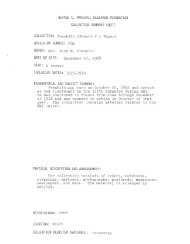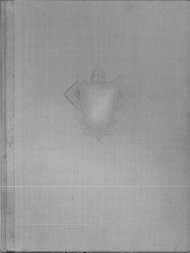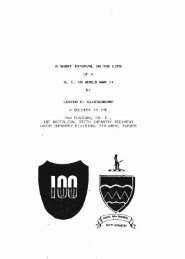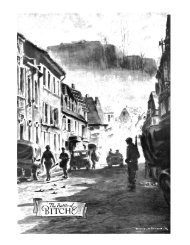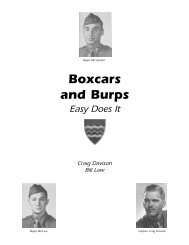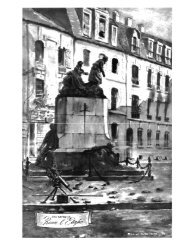appendix awards and decorations - The George C. Marshall ...
appendix awards and decorations - The George C. Marshall ...
appendix awards and decorations - The George C. Marshall ...
You also want an ePaper? Increase the reach of your titles
YUMPU automatically turns print PDFs into web optimized ePapers that Google loves.
186 THE 398TH INFANTRY REGIMENT<br />
sault boats in the village <strong>and</strong> carried them to the banks of the stream.<br />
Company E was on the left flank, Company G in the center <strong>and</strong> Company<br />
F on the right. <strong>The</strong> leading platoons from each company pushed<br />
off at approximately the same time <strong>and</strong> reached the far shore without<br />
meeting any opposition. <strong>The</strong> men quickly unloaded <strong>and</strong> began running<br />
across the one hundred <strong>and</strong> fifty yards of open terrain towards the<br />
railroad embankment, which bordered the high ground <strong>and</strong> wooded<br />
area directly ahead. As the riflemen moved across the grassy field they<br />
were suddenly fired on by enemy machine gunners <strong>and</strong> riflemen entrenched<br />
in the woods on both flanks. Some of the men hit the ground<br />
immediately, but the majority of them continued on until they reached<br />
the embankment, which offered some protection. Seeing what had happened,<br />
the men left on the Duttenberg side immediately formed a skirmish<br />
line <strong>and</strong> began firing back at the foe. However, it became apparent<br />
that if we were to hold the bridgehead already established, the<br />
remaining units of the companies would have to cross over <strong>and</strong> continue<br />
the attack. A patrol from Company E discovered a small dam<br />
across the river a short distance upstream <strong>and</strong> it' was decided that both<br />
Companies G <strong>and</strong> E would be able to infiltrate across the narrow wall<br />
<strong>and</strong> make a run for the embankment. Two sections of heavy machine<br />
guns were emplaced <strong>and</strong> they attempted to pin down the enemy while<br />
the riflemen forced their way across the stream. Although one of the<br />
guns was knocked out of action, the other three continued to deliver a<br />
steady stream of covering fire <strong>and</strong> both companies reached the far<br />
shore. However, Company F was receiving fire from three sides <strong>and</strong> it<br />
was impossible for them to fight their way ahead. <strong>The</strong> comm<strong>and</strong>ing<br />
officer decided to continue on down the river, hugging the bank as<br />
long as possible, until they got within the city of Jagstfeld. After reorganizing<br />
Company E was ordered to continue on down the tracks<br />
to the village of Heuchlingen. As they moved out the 81mm mortar<br />
platoon began laying smoke shells along the railroad to partially conceal<br />
their movements. At the same time they fired high-explosive shells<br />
into the small patch of woods on the right in an attempt to keep the<br />
Germans in their dugouts. <strong>The</strong> mortar fire was so close that out own<br />
men were in constant danger of being wounded by shrapnel, but it was<br />
the only way that the foe could be effectively pinned down. Later in<br />
the day one platoon from the company was cut off while trying to outflank<br />
the enemy positions <strong>and</strong> forced to fight its way back to Duttenberg<br />
under cover of darkness. Company G started across the flat farml<strong>and</strong><br />
northeast of Jagstfeld at approximately 1100 hours, but they soon ran<br />
into the enemy's main defense line <strong>and</strong> were stopped dead. By 1500<br />
houts the company's effective combat strength was cut down to less




